As Paul Heyman said in a 2022 interview with Fox Sports, Professional Wrestling in the 1990s needed disruption, and Heyman was willing to be the disruptor.
When last we left the tale of Heyman’s career in professional wrestling, he had done just that.
After becoming sole creative director of Eastern Championship Wrestling in 1993, he began shifting the promotion’s image to line up with the grittier, edgier styles that had come into the mainstream with the rise of Alternative Rock and Gangsta Rap just a few years earlier.
As we will continue to chart Paul Heyman’s legacy of hustle, as Extreme Championship Wrestling sets the template for pro wrestling in the 90s and 2000s.
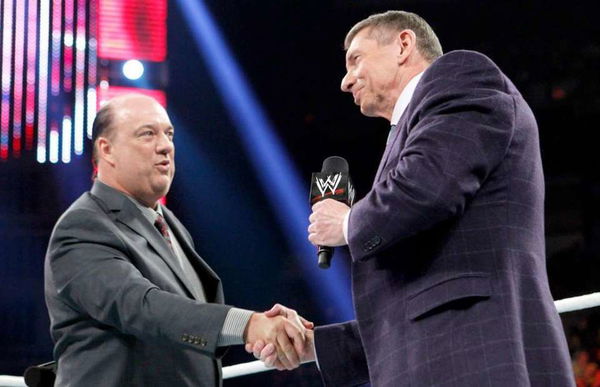
Paul Heyman –
ECW and Vince McMahon
ECW’s rise to the #3 wrestling promotion in North America arguably began at the 1995 King of The Ring PPV.
That night, the intensely loyal ECW fanbase in Philadelphia made their voices heard when they started up the infamous “E-C-Dub!” chant during the tournament finals between Savio Vega and Mabel.
This brought ECW onto Vince McMahon’s radar for the first time. The following year would be a difficult one for McMahon and the WWF, as top stars Kevin Nash and Scott Hall signed contracts with competing promotion World Championship Wrestling.
In WCW, Hall and Nash portrayed a duo of WWF wrestlers bent on “invading” WCW, eventually teaming up with WCW’s top star Hulk Hogan to wage war on WCW as the New World Order.
This development was a dramatic departure from what either WCW or WWF programming had been until that point, blurring the lines between what was real and what was an angle.
This gritty, edgy storyline brought a great deal of publicity to WCW, which translated quite easily into ticket sales, merchandise sales, and TV ratings.
This exacerbated the already declining popularity of the WWF in their New Generation era. McMahon needed to come up with something to bring attention to his programming, and so he looked to Paul Heyman.
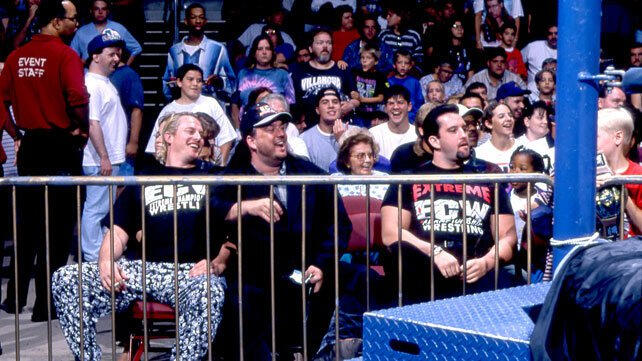
That already sizeable chip began to grow in 1995, when WCW president Eric Bischoff started poaching ECW’s mid-card talent like Eddie Guerrero, Dean Malenko, Rey Mysterio, and others.
This, combined with a desire to bring ECW to pay-per-view, made him much more amenable to working with McMahon and the WWF. Together, Heyman and McMahon hatched a plan to counter WCW’s nWo angle.
At 1996’s In Your House: Mind Games, Paul Heyman sat in the front row along with The Sandman, Tommy Dreamer, and Taz, all wearing ECW t-shirts.
During the opening bout, a strap match between Savio Vega and Justin “Hawk” Bradshaw, The Sandman caused a minor interference by spitting beer into Vega’s face before security dragged him out.
Vince McMahon addressed this on commentary, saying that the wrestlers were from “an up-and-coming local promotion.” The following night on RAW, Taz, and Bill Alfonzo jumped the guardrail during a match between The Bodydonnas and Owen Hart & The British Bulldog.
Once over the rail, Taz held up a sign reading “Sabu Fears Taz – ECW.” The stunts did indeed bring attention to both ECW and the WWF, but it wasn’t quite enough to bring them up to speed with WCW.
Regardless, both parties viewed the angle as a success, and they started a talent-sharing agreement shortly thereafter.

ECW Invades Monday Night RAW
Early in 1997, Jerry “The King” Lawler became vocal about his distaste for ECW and the media coverage they were getting after their appearances the following year.
On the February 17th episode of Monday Night RAW, a pair of ‘fans’ carrying ECW signs were planted right behind the commentary desk.
Lawler snatched one of their signs and before saying ECW was full of “misfits and has-beens who couldn’t make it in the WWF” before tearing up the sign.
He followed this by challenging anyone from ECW to show up at the following week’s RAW taping from the Manhattan Center in New York.
Later on in the show, during a match between Flash Funk and Owen Hart, Paul Heyman called in to accept the challenge, kicking off the feud between Jerry Lawler and ECW.
The following week’s Monday Night RAW saw the Manhattan Center packed with the ECW faithful, all chanting for their favorite promotion. After the opening contest between The New Blackjacks and The Godwinns, Paul Heyman and The Eliminators stormed the ring.
ECW’s Tag Team Champions Kronus and Saturn subjected a ‘ring attendant’ to the Total Elimination before Heyman took to the microphone, declaring that ECW had arrived.
Heyman was right in a more profound way than anyone realized. Rather than having ECW wrestlers tangle with WWF wrestlers, McMahon decided to give ECW 3 matches to give viewers a taste of their style.
Heyman sat in on commentary as Little Guido took on Stevie Richards and the bWo, Mikey Whipwreck wrestled Taz, and Tommy Dreamer wrote another chapter in his feud with The Dudley Boyz.
After Dreamer’s pinfall victory over D-Von Dudley, Bubba Ray came in to assist in a 2-on-1 beatdown, only to be sent packing by the arrival of The Sandman.
Meanwhile, on commentary, tensions between Heyman and Lawler boiled over, with several ECW locker room members having to restrain their boss as he tried to get his hands on The King.
“They needed a boost and we needed a boost” Tommy Dreamer said of the event in a WWE Classics interview.
“WWE was getting their butt kicked by WCW, and they needed something that said you have to tune in to Monday Night Raw because anything could happen.
Paul said we were working on deal with WWE to get us national exposure, but not a lot of people know about it.
I think it was Paul, Mr. McMahon and Bruce Prichard – the head of talent relations at the time. That was it.”
ECW Comes Of Age
The cross-promotion with the World Wrestling Federation was just what ECW needed at that point.
Heyman had been working to get ECW onto pay-per-view, but until that point, the most exposure ECW had ever gotten was for an incident in 1996 when 17-year-old Erich Kulas was seriously injured in a match.
Thanks to the appearance on RAW and a fanmail campaign, Premier and Request TV agreed to carry ECW Barely Legal on April 13th.
In a streak of luck for pro wrestling fans and historians, this was also around the time Barry Blaustein started production on the documentary Beyond The Mat.
Blaustein’s crew were there behind the scenes when Barely Legal went on air, capturing the backstage atmosphere and Paul Heyman’s rousing pre-show speech.
ECW Barely Legal drew a $66,000 box office from attendance and drew approximately 60 000 buys for an overall buyrate of 0.26.
It wasn’t as impressive as buyrates for WCW or WWF pay-per-views, but it was enough to kick off a string of regular ECW pay-per-view events that lasted until the company’s closure in 2001.
In August of 1999, Paul Heyman secured a broadcast deal with The Nashville Network, leaving the local stations ECW had called home for the past six years.
The show was an odd fit for the country-music-centered channel, who felt like getting in on the wrestling boom would allow them to compete with TNT and USA. However, they didn’t quite understand what they were getting when they gave ECW a time slot.
TNN management regularly butted heads with Heyman over ECW’s content, regularly requesting they tone down the sex and violence.
Meanwhile, Heyman describes getting TNN to air commercials for ECW as an uphill battle, even though ECW on TNN was among their highest-rated shows. These conflicts with TNN led to the creation of a villainous stable known as The Network.
Making matters worse for Heyman, WCW and the WWF poached top stars Mike Awesome, Taz, and The Dudley Boyz within weeks of their debut on TNN.
In October of 2000, just over a year after their debut on a national network, ECW on TNN was canceled in favor of WWF RAW is WAR.
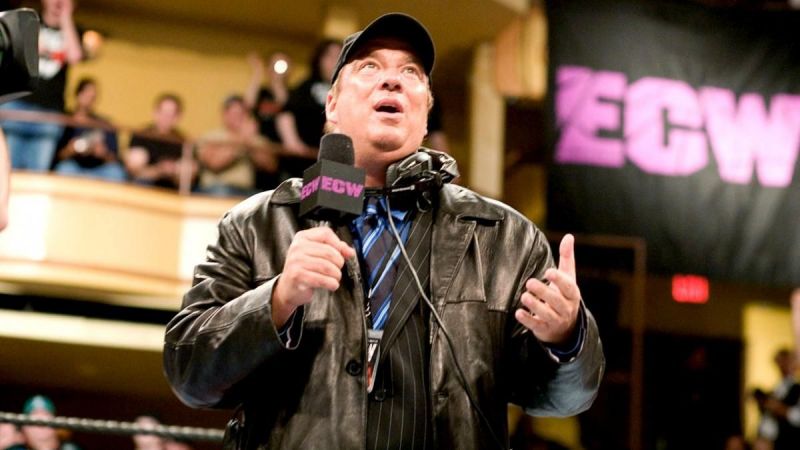
Financial Troubles and Buyout
While Heyman had always had a mind for the wrestling side of the business, he was never particularly good at the money side of the business.
ECW struggled financially for its entire lifespan, but the final years of the promotion saw wrestlers going months at a time without getting paid. Toward the end of ECW’s lifespan, Heyman was effectively persona non grata in his own promotion.
Thankfully, Paul Heyman was only too happy to teach his wrestlers how to run the business side of things, and his protege Tommy Dreamer was able to pick up the slack and book shows.
Meanwhile, Heyman was off trying to secure a new national TV deal. But come 2001, the writing was on the wall, as Heyman returned to the WWF as a commentator, replacing Jerry Lawler and resuming his old WCW rivalry with Jim Ross.
One month later, in March of 2001, WWE would purchase WCW and followed up by buying ECW at the start of April. Vince McMahon tried to continue with WWF controlling SmackDown! on UPN while WCW would take over Monday Night RAW on TNN.
However, no TV companies were willing to touch WCW over its reputation for losing money. In the end, the WWF decided to stage an invasion angle.
In the lead-up to King of The Ring 2001, many former WCW and ECW stars had made their debut in WWE, including Booker T, DDP, and Rob Van Dam.
These non-WWF wrestlers bore a chip on their shoulder, having worked for years to build an alternative to the WWF.
Initially, the WCW stars banded together to fight WWF talent. ECW stars joined on July 5th, when Rob Van Dam, Taz, Tommy Dreamer, The Dudley Boyz, and a handful of other ECW stars took to the ring for a beatdown on Kane and Chris Jericho.
That’s when Heyman came out from behind the commentary desk to announce the arrival of ECW. However, he shortly handed the reigns over to Stephanie McMahon, who combined her ECW with Shane McMahon’s WCW to form The Alliance.
This lasted until the RAW after the 2001 Survivor series, where Heyman was ‘fired’ from commentary and replaced by the returning Jerry Lawler. However, Paul Heyman’s career in the WWF was far from over.
Managing Lesnar and Leading SmackDown!
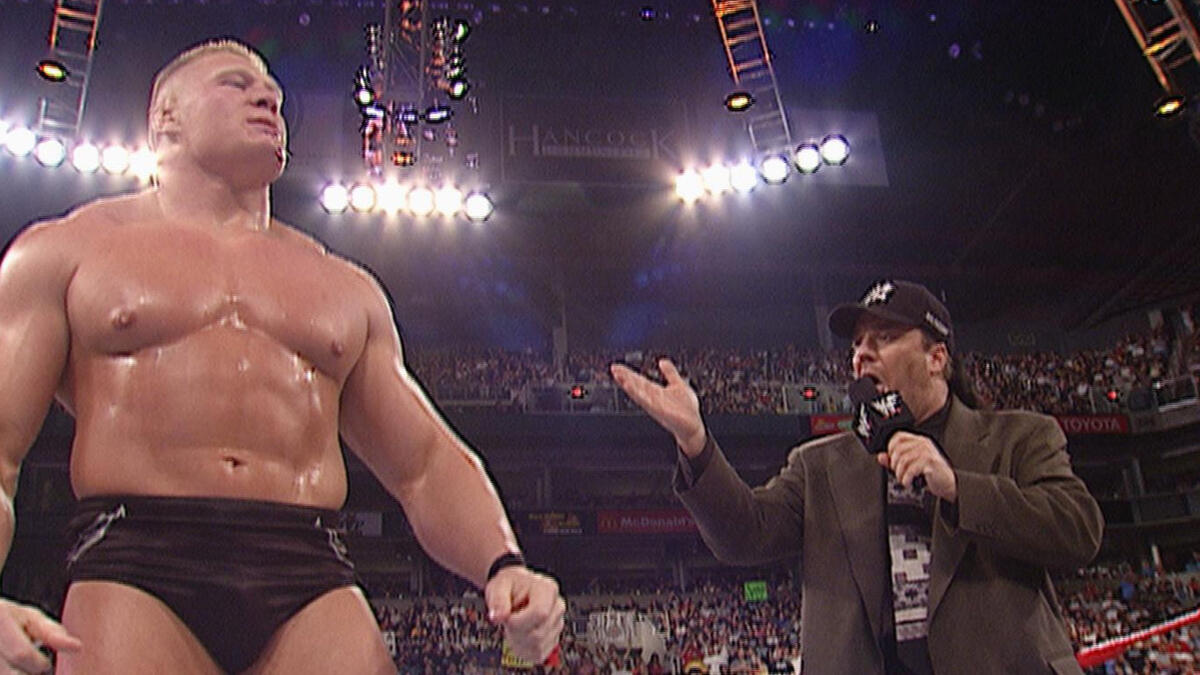
Calling the shots at his side was none other than Paul Heyman, who presented himself as Brock Lesnar’s personal agent. With Heyman’s command of language and Lesnar’s impressive strength and agility, the two shot right up the card.
Brock Lesnar captured his first WWE World Championship from The Rock just five months after he debuted. During this time, Brock Lesnar made the WWE Championship SmackDown!-exclusive, deepening the already-established brand extension.
While Heyman was managing Brock Lesnar and later the Big Show, he was also in charge of creative for SmackDown! In an oral history for Bleacher Report, Heyman said:
“SmackDown was in serious trouble. It was relegated to being the B show, even by internal WWE standards. Dean Valentine at UPN was strongly considering not renewing the show.
SD was in peril. If not a cancellation, a non-renewal. Something had to be done to save that brand.”
Under Heyman’s leadership, Edge, Rey Mysterio, Kurt Angle, Chris Benoit, and Los Guerreros would become “The SmackDown Six” leading SmackDown! to become a true competitor to RAW rather than a B-Show.
This period would also see the rise of an up-and-coming LA-area wrestler by the name of John Cena. Then, in October of 2003, Heyman would become on-screen General Manager of SmackDown!, a role he would hold until March 22nd, 2004.
That night, RAW GM Eric Bischoff drafted Heyman to RAW, with intentions to use him as a personal assistant. An incensed Heyman announced that he would rather ‘quit’ than come to work for the man who had poached his talent for WCW.
The following week, Heyman would be replaced with Kurt Angle as GM of SmackDown!. Meanwhile, Heyman would return as manager for The Dudley Boyz and Heidenreich in their feuds against The Undertaker for the rest of 2004.
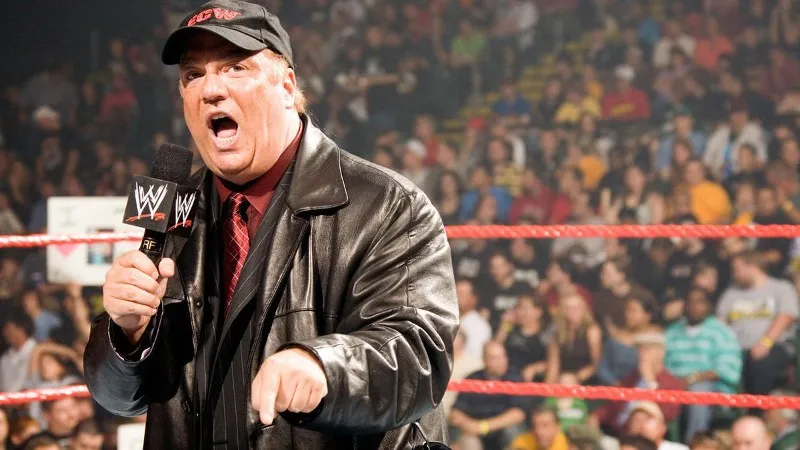
OVW and The Return of ECW
In the mid-2000s, WWE started up a partnership with Danny Davis’ Ohio Valley Wrestling. Located in Louisville, Kentucky, OVW would serve as a place for WWE prospects to learn how to wrestle and give promos in WWE’s house style, before they debuted on national television.
Heyman took over as booker/head writer for OVW in 2005, and treated it similarly to how he treated ECW.
On top of making stars out of The Spirit Squad (featuring the future Dolph Ziggler) and CM Punk, he also made time to teach wrestlers about the business side of things.
In an interview with Ryan Satin for Fox Sports, Heyman explained that he would have open production meetings on Wednesday mornings so that wrestlers could learn how to put together a show.
According to Heyman, this gave wrestlers tools they could use to remain in the industry when injuries made it impossible to wrestle.
However, while Heyman was busy re-shaping Ohio Valley Wrestling, something interesting was happening in the wrestling culture.
ECW had been seen as a less-prestigious alternative to the WWF in the 90s, but in the years following their closure, fans had begun to recognize how truly influential the hardcore promotion had been.
ECW loyalists would come to WWE shows and chant “E-C-Dub!” whenever something characteristic of the old promotion happened. This led WWE to run two ECW revival PPVs under the “ECW One Night Stand” title in 2005 and 2006, respectively.
These PPVs were so successful that they re-launched ECW as a third brand in 2006. However, this was a stripped-down version of the promotion fans fell in love with a decade prior.
Low TV ratings and a disastrous December to Dismember PPV led to Heyman’s removal from his roles. He would quietly leave WWE shortly thereafter.
2012 Return and “Paul Heyman Guys”
On April 2nd, 2012, the night after WrestleMania XXVIII, Brock Lesnar made his return to WWE. He had left in 2004 to pursue a career in the NFL, followed by a dominant run in the UFC.
However, when he returned to the WWE, it became clear that his promo skills hadn’t developed. After a lackluster promo against RAW GM John Laurinaitis, WWE reached out to Paul Heyman for a return.
Heyman was initially hesitant to return, but reconsidered when he learned it was Lesnar who requested it. On May 7th, 2012, Paul Heyman returned to Brock Lesnar’s side, this time as Lesnar’s ‘legal counsel’ rather than as a manager/agent.
In this role, Heyman employed many of the mannerisms he had seen his father use as a personal injury attorney. In this role, Heyman would oversee Brock Lesnar’s transformation from regular competitor to special attraction, appearing only at ‘big 4’ PPVs.
Meanwhile, CM Punk would invoke Paul Heyman’s name in the infamous “Pipe Bomb” promo, calling himself a “Paul Heyman Guy.” This would lead to an on-screen partnership between the two after Punk captured the WWE Championship.
Later on, WWE would attempt to capitalize on Punk’s words by giving Heyman a stable of ‘Paul Heyman Guys’ to manage. Around this time, Heyman would turn heel on Punk and manage Brock Lesnar, Curtis Axel, and Punk’s new rival, Ryback.
However, Axel and Ryback weren’t quite as impressive as Brock Lesnar or as captivating as CM Punk, and they would quietly fall into the background as Lesnar geared up for a clash with The Undertaker at WrestleMania XXX.
That night, Brock Lesnar would go down in history as the man to break The Undertaker’s legendary undefeated 21-match undefeated streak at the flagship event.
The following night, Antonio Cesaro would announce himself to be the newest Paul Heyman Guy, but with little planned for him otherwise, he would remove himself from the group just three months later. Heyman himself would remain Brock Lesnar’s manager.

Lesnar’s Championship and Other Roles
Under Paul Heyman’s management, Brock Lesnar would go on to be one of the most dominant champions of the modern era. Lesnar would hold the WWE or Universal Championship for a total of 1,138 days between the SummerSlams of 2014 and 2019.
Also in 2019, Heyman became Executive Director of RAW in addition to serving as Lesnar’s manager on SmackDown. However, that would not last long, as Lesnar returned to RAW in the later months of 2019.
Paul Heyman would represent Brock Lesnar up until his match against Drew McIntyre at WrestleMania 36, when Lesnar lost the WWE Championship in under 5 minutes.
Following the first fan-less WrestleMania, Lesnar opted not to renew his contract with the WWE. During this time, Heyman returned to a backstage role, but just like last time, it wouldn’t last long.
On the August 28th, 2020 episode of SmackDown, Heyman returned to television screens. This time not as a manager to Brock Lesnar, but to Lesnar’s longtime rival Roman Reigns.
The former muscle of The Shield had returned at SummerSlam that year, immediately turning heel.
Among Reigns’ first actions in turning heel was to retain Paul Heyman as ‘special counsel’ before capturing the Universal Championship in a triple threat match at Payback 2020.
In October of that year, Reigns would enter a feud with his cousins Jimmy and Jey Uso, which culminated in an emotional moment at Hell in a Cell.
During an “I Quit” Hell in a Cell match between Reigns and Jey, the champion would lay a beatdown on an injured Jimmy Uso, forcing Jey to quit, and as a result, submit to Roman’s authority.
This was the beginning of a new faction, The Bloodline, who would dominate WWE as champions from late 2020 to 2023, when the Usos would split up.
Heyman remains as Reigns’ ‘Special Counsel’ cutting promos for and defending the fourth-longest-reigning champion in WWE history.
And there you have it; A career in wrestling lasting almost 50 years. We started this career retrospective with Heyman’s conjecture that he’s never held a “real” job.
Whether you agree or disagree about what is or isn’t a “real” job, hopefully, we’ve made it clear that Paul Heyman did one hell of a job in the unreal career of professional wrestling.










